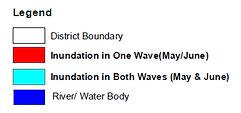Reconnect
In Assam, the flood is a natural disaster and it's occurring due to the excessive rainfall, and the people are affected every year. The Assam State Disaster Management Authority also took various initiative steps to control the flood and erosion in Assam. This project addresses this issue and tries to reconnect us with these occurrences.
Objective:
To address the lack of shelter during floods in inundated rural areas in Assam
Project Duration:
eight weeks





River Brahmaputra
It is a turbulent river with heavy siltation. This is the reason for its large flood plains. Due to its turbulence, soil erosion is rapid and the water enters human settlements across its path.

Prolonged Monsoons
The propensity to have prolonged rains is higher. As a result, water from the adjoining hills enters the valley and adds to the flooding conditions of the land.
The propensity to have prolonged rains is higher. As a result, water from the adjoining hills enters the valley and adds to the flooding conditions of the land.

Melting Glaciers
With rising climate change, the water level in River Brahmaputra is rising. As the river originates in a glacial region, the melting of glaciers coincides with the monsoons in the lower plains.


According to Annual Flood Report 2022

5,580
villages affected in 32 districts
8,100
houses were damaged
5,542,100
people were affected
862
relief camps were built
262,155
got shelter in relief camp
Preparing for floods?

Effective Watershed Mapping

Spreading Awareness about floods

Integrated Basin wide solutions

Developing better communication channels

Pre Disaster announcements

Improving relief response infrastructure in inundated areas
Our main resources does not lie in structural or non - structural measures but the people of Assam who have been battling floods for many years.
~ Piyush Saikia (IRCS)
Community Involvement in Flood Relief

Relocation

Allocation of rations by various organizations

Community Discussions

Collective efforts for search parties
Scenario of service provision in inundated areas

Focus Area
Secondary Focus Area
Partial Involvement
The gaps in the provisions of basic services such as shelter and communication can be improved by design intervention for people to avail it effectively.
Stages of Intervention
1
Product Level Intervention
Affectively aids search and rescue missions and at the same time shelters the affected families
2
Creating Awareness
Develop an understanding about floods, to inform & educate people of water and the culture associated to it
3
Water Index Calculation
Understanding the concept of wetness and associating it with a Water Index
Product Level Intervention - Ideations

Inspiration for the Form

Cranes are found in wetlands and flood plains and have a cultural association with wetness

Meji are close to silos and are used to store hay for cattle and are found in large numbers around houses in rural Assam
Final Form
The idea for such a form is to have a place to stay in till the rescue team arrives or till the water level subsides.

8 nos of 10 ft banana stems at each raft base

8 nos of 10 ft banana stems at each raft base





Tarpaulin sheet is readily available for use which can be wrapped around the pod for safety during rains
Bamboo is available for different form of construction in Assam, it is light weight, flexible and stable
Banana plant grows up to 23ft and floats even after it is rotten
Average raft size
10 ft x 8ft
6 ft X 7 ft for side panels
6 ft X 13 ft top panel
Design Details



Creating Awareness

Wetness is not just limited to rivers and ponds, it is present in every aspect of one's surroundings. The imageability of rivers has changed the mindset of people towards water. Most ancient civilizations lived cohesively, not seeing floods as a hindrance but as a part of a natural process of the ecosystem they live in. So where can we bring about change as designers? It is the education and awareness through different modes that can help this idea sit with people.
Another interesting anecdote of living in cohesion with rivers is seen in Majuli island of Assam. Here the first wave of flood is prayed to as it deposits fertile alluvial soil into the paddy fields. After which the saplings are planted into the soil and the second wave of water irritates it. Water is an essential aspect of the lives of these people and therefore have developed techniques to live in symbiosis with the river Brahmaputra.


Indexing and Mapping
A water index essentially measures the amount of rainwater which the land absorbs. An area which absorbs more will be less prone to floods. Intuitively a city will have low absorption rate.


